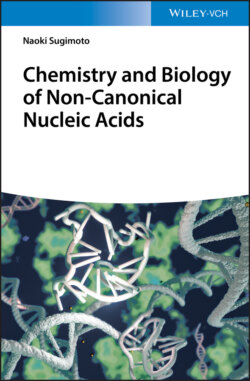Читать книгу Chemistry and Biology of Non-canonical Nucleic Acids - Naoki Sugimoto - Страница 23
2.2.3 Purine–Purine Mismatches
ОглавлениеPurine–purine and pyrimidine–pyrimidine mismatches are known as transversion mismatches. There are G·A, G·G, and A·A mismatches in the purine–purine mismatch. Among them, G·A mismatch forms relatively stable unusual base pairs in both DNA and RNA duplexes (Tables 2.1 and 2.2). It is highly polymorphic depending on sequence compositions. In DNA duplexes containing G·A mismatches that form two hydrogen bonds, various combinations of anti and syn were observed in their glycosidic bond angles (Figure 2.3). G·G mismatch potentially adopts a base paring with two hydrogen bonds, in which two guanosines are symmetrically or asymmetrically oriented with anti and syn conformation in their glycosidic bond angles (Figure 2.3). When the asymmetric G·G base pairs face each other in rotation, four guanines form a symmetric quartet as described later (Chapter 3). Recent X-ray diffraction analyses also demonstrated polymorphic feature of the G·G mismatch by showing that with syn–syn combination in the glycosidic bond angles in the presence of chromomycin A3, which binds minor groove of the mismatched place and supports the structure analysis [8]. Detailed structure of A·A mismatch is rarely determined by X-ray diffraction analysis. It is considered that the mismatch is dynamically fluctuated and not able to be a particular structural state.
Table 2.1 Thermodynamic parameters for duplex formations in 1M NaCl by DNA oligonucleotides containing mismatchesa).
| −ΔH° | −ΔS° | −Δ | T m | ||
|---|---|---|---|---|---|
| Sequence | XY | (kcal mol−1) | (cal mol−1) K−1) | (kcal mol−1) | (°C at 10−4 M) |
5′CAAA X AAAG | CG | 64.5 | 183 | 7.7 | 42.9 |
3′GTTT Y TTTC | GC | 62.8 | 179 | 7.3 | 40.8 |
| AT | 68.0 | 196 | 7.2 | 40.1 | |
| TA | 58.6 | 168 | 6.5 | 36.8 | |
| GG | 53.5 | 158 | 4.5 | 25.6 | |
| TG | 55.6 | 165 | 4.4 | 25.7 | |
| GA | 52.6 | 156 | 4.2 | 23.9 | |
| GT | 46.7 | 137 | 4.2 | 22.3 | |
| AG | 39.9 | 116 | 3.9 | 18.0 | |
| AA | 36.9 | 107 | 3.7 | 15.0 | |
| CT | 53.2 | 161 | 3.3 | 19.1 | |
| TC | 50.0 | 151 | 3.2 | 17.5 | |
| CA | (40.3)b) | (120)b) | (3.1)b) | (13)b) | |
| TT | (54.6)b) | (167)b) | (2.8)b) | (17)b) | |
| AC | (35.8)b) | (106)b) | (2.9)b) | (9)b) | |
| CC | (55.3)b) | (171)b) | (2.3)b) | (15)b) | |
5′CAACTTGATATTAATA + | Mismatch | ||||
3′GTTGAACTATAATTAT | – | 102.1 | 289 | 12.4 | 55.8 |
3′GTTGAGCTATAATTAT | TG | 92.6 | 266 | 10.1 | 49.4 |
3′GTTGAACTATAGTTAT | TG | 95.5 | 274 | 10.5 | 50.5 |
3′GTTGAACTCTAATTAT | TC | 98.4 | 286 | 9.7 | 47.3 |
3′GTTGAATTATAATTAT | GT | 91.3 | 264 | 9.4 | 47.1 |
3′GTTGAACCATAATTAT | AC | 90.9 | 265 | 8.7 | 44.6 |
3′GTTGAACAATAATTAT | AA | 92.0 | 267 | 9.26 | 46.2 |
a) Values are summarized ones in a reference [6].
b) Values in parenthesis are significantly less accurate estimated using flat lower baselines in their melting analyses.
Table 2.2 Free energy increments for tandem mismatches in RNA oligonucleotides in 1M NaCla), b).
| Mismatch | YZ ZY | ||||||||||||
|---|---|---|---|---|---|---|---|---|---|---|---|---|---|
5′ CGX YZX′ CG 3′ | UG | GU | GA | AG | UU | GG | CA | CU | UC | CC | AC | AA | |
3′ GCX′ ZYX GC 5′ | GU | UG | AG | GA | UU | GG | AC | UC | CU | CC | CA | AA | |
| Closing base pair | |||||||||||||
X/X′ | G/C | −4.9 | −4.1 | −2.6 | −1.3 | −0.5 | 1.0 | 1.1 | 0.9 | 1.5 | |||
C/G | −4.2 | −1.1 | −0.7 | −0.7 | −0.4 | 0.8 | 1.1 | 1.4 | 1.4 | 1.7 | 2.0 | 1.3 | |
U/A | −2.6 | −0.3 | 0.7 | 1.1 | [1.9]C | 2.2 | 2.8 | 2.8 | |||||
A/U | −1.9 | 0.2 | 0.3 | 0.6 | 2.3 | 2.5 | 2.8 |
a) Values are summarized ones in a reference [6].
b) Values are increments of the stabilities (Δ in kcal mol−1) compared with self complementary duplex consisting of CGXX′CG sequence, where X and X′ are nucleobases in the left column.
c) The sequence has either an unusual conformation or mixture of conformations.
Figure 2.3 Mismatched G-A and G-G base pairs observed in nucleic acid structures. (a) G-A mismatched base pairs with various compositions in their glycosidic bond angles. (b) Symmetric (left) and asymmetric (right) G-G mismatched base pairs.
